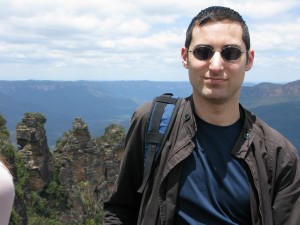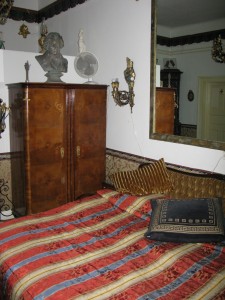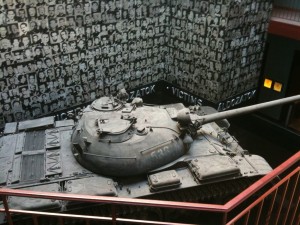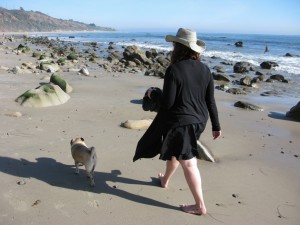If you think about it, the International Date Line is an arbitrary human creation; an imaginary line running down the planet where we as a species have decided “the day starts here.” It’s still difficult for me to visualize, but I think of it as the spot where time slips into the world, only to forever slip away once it completes its circumnavigation.
However arbitrary it may be, and however equally arbitrary is our measuring of years, they hold significance to us, and rituals have sprung up surrounding them. Back in the Northern Hemisphere, however, New Year’s Eve has always struck me as something of a contrivance, a bogus reason to celebrate in the middle of winter, as if to hold on to those lingering embers of Christmas that much longer.
But here on the other side of the globe, New Years coincides with the arrival of summer; and given where the Date Line is positioned, smack dab in the middle of the Pacific, New Zealand and Australia are the first large populated regions to greet the New Year. All those factors have made the holiday something of a big deal in these parts — a fact popularized during the turn-of-the-millennium celebrations, when those awesome fireworks shooting off the Harbour Bridge first made me say “I need to see that!”
Trouble is, I wasn’t the only one. The holiday’s big business here, with primo-view tickets for parties at the Opera House asking around $1000. Even the party at moderately-close Darling Harbour that two friends of Mikey’s were attending went for north of $100 – and it was sold out.
We got a further whiff of the scale of it all as we met Sarah during the day on December 31st at the Art Gallery of New South Wales for a Picasso exhibit they were having on loan from the namesake museum in Paris; as it was one of the City of Light’s attractions I’d missed on my spin through there two-and-a-half years ago, I figured this would make for a pleasant daytime diversion.
As we walked to the red sandstone museum, we dodged security guards and long, snaking lines. No, they weren’t here for the art; these folks were queued up before noon to see fireworks that were still twelve hours away. Yikes. We took in the artistic retrospective – a pretty comprehensive showing of the iconic artist whose career seemed to drag on for the entire twentieth century.
 After a bit of lunch we went on a reconnoiter, filling in a few more gaps in my explorations of central Sydney. We walked down the Finger Wharf of Woolloomooloo, peeking into the former industrial building now converted to condos and a luxury hotel. Conveyor belts that used to carry ship cargo stood forever frozen amid high-tone bars and offices on the ground floor. As with so many once-derelict industrial spots in prime harborfront locales, this is yet another example of the ambivalence I feel about the continuing creep of gentrification.
After a bit of lunch we went on a reconnoiter, filling in a few more gaps in my explorations of central Sydney. We walked down the Finger Wharf of Woolloomooloo, peeking into the former industrial building now converted to condos and a luxury hotel. Conveyor belts that used to carry ship cargo stood forever frozen amid high-tone bars and offices on the ground floor. As with so many once-derelict industrial spots in prime harborfront locales, this is yet another example of the ambivalence I feel about the continuing creep of gentrification.
We passed the diminutive naval base nearby – I’m struck by how this small facility fits in so nicely with the urban surrounds, cool gray ships and masts comingling with Sydney Victorians. In America such bases are typically isolated and monolithic, a by-product of the nation’s massive imperial military and post 9/11 security tightening. Here some crowds were gathered as well in anticipation of the night’s fireworks – and it was here, just up the hill amid the quiet, leafy streets of Potts Point, that we discovered a decent viewing spot for the night’s festivities: close in enough to see the bridge and the water, but not so close as to require multi-hour waiting.
 As it grew dark we returned to this spot, walking down from Oxford Street in Darlinghurst through Kings Cross and on to Potts Point. Sydney’s in-town neighborhoods are pretty compact: this amble totaled maybe twenty minutes. Our earlier reconnoiter proved a good choice: the crowds at the end of Victoria Street were substantial but not overwhelming, more local folk headed out for their annual fireworks viewing. Sydney’s big show is so popular they now have two rounds of it, one at 9 o’clock for families before the (literal) big blowout at midnight when the clock strikes next year. Even at their earlier showing, with a view blocked by a few trees, the event impressed: a coordinated series of volleys across multiple spots around the Harbour, capped off with – this is something I hadn’t seen before – additional bursts from nearby downtown office buildings.
As it grew dark we returned to this spot, walking down from Oxford Street in Darlinghurst through Kings Cross and on to Potts Point. Sydney’s in-town neighborhoods are pretty compact: this amble totaled maybe twenty minutes. Our earlier reconnoiter proved a good choice: the crowds at the end of Victoria Street were substantial but not overwhelming, more local folk headed out for their annual fireworks viewing. Sydney’s big show is so popular they now have two rounds of it, one at 9 o’clock for families before the (literal) big blowout at midnight when the clock strikes next year. Even at their earlier showing, with a view blocked by a few trees, the event impressed: a coordinated series of volleys across multiple spots around the Harbour, capped off with – this is something I hadn’t seen before – additional bursts from nearby downtown office buildings.
We were going to hang around for the midnight fireworks, but then Mikey received a text from one of his friends: a mutual pal of theirs was having a party at their high-rise apartment nearby with a view of the Harbour. Would we be interested to join? I was hesitent to give up my hard-won view spot for what could simply be another party, but I acquiesced and figured I’d see where the night took me.
I’ve long since discovered, in my travels, the virtues of serendipity – something that doesn’t always come easily to an uber-planner/organizer like myself. But when we showed up at this New Years party, on the fifteenth floor of a swank Sydney condominium, my belief in the unexpected took a new turn.
 We walked in to a two-story place with floor-to-ceiling windows. A broad, white modern sectional sofa was flanked by a kitchen on one side and a narrow terrace on the other. Outside the windows the view was phenomenal, tracing a broad arc from Sydney’s CBD on one end to Kings Cross, Darlinghurst, and the eastern beach suburbs beyond.
We walked in to a two-story place with floor-to-ceiling windows. A broad, white modern sectional sofa was flanked by a kitchen on one side and a narrow terrace on the other. Outside the windows the view was phenomenal, tracing a broad arc from Sydney’s CBD on one end to Kings Cross, Darlinghurst, and the eastern beach suburbs beyond.
Although a ways off in the distance, the fireworks were nonetheless stellar as they went off at midnight. Mikey and I shared a sweet New Years kiss; I mused on the upsy-downsy year that 2011 had been. Hopefully 2012 will be ever smoother… definitely can’t complain about how it started out.
We didn’t get to bed too late, so the next morning, with the weather having turned spectacular (sunny, high-seventies), I opted to pick up where’d I’d left off almost nine years ago: back then I’d taken the cliff walk from Bondi to Bronte; this time, I aimed to head the other way, northward from Coogee to Bronte along the jagged, sandstone cliffs bounding the blue sea.
 The walk in this direction was even more spectacular than the trek down from Bondi, at least if memory serves: from the expansive sandy arc of Coogee Beach I ascended a grassy incline topping white sandstone cliffs. The erosion patterns on the rocks formed perfect, even rows, as if some carver had gone through with a giant steel comb. The ocean here is a magnificent, iridescent blue – the sort you see in tourist brochures and think “Photoshop.”
The walk in this direction was even more spectacular than the trek down from Bondi, at least if memory serves: from the expansive sandy arc of Coogee Beach I ascended a grassy incline topping white sandstone cliffs. The erosion patterns on the rocks formed perfect, even rows, as if some carver had gone through with a giant steel comb. The ocean here is a magnificent, iridescent blue – the sort you see in tourist brochures and think “Photoshop.”
Passing Clovelly Beach, I came upon a graveyard sloping gently toward the cliffs over the sea; I think I now know where I want to be buried. And, finally, Bronte, wher the crowds were thick on this New Years afternoon.
It’s become standard to me that travel is a means of learning about oneself, and walks like this one definitely feed the brain. So what grand new revelations did this trek portend? Nothing earthshattering, though a part of me sometimes wonders if I’ve been running in place in the nine years since I hiked these cliffs. I’m still doing the same work (albeit with better pay and better working conditions overall); I’m again a relatively-recent homeowner; I’m still finding my place in the social sphere and continue to feel like a bit of an outsider everywhere I go; and I’ve got a few more scars nine years on – some of them literal.
 But still, much forward movement: six wonderful nieces and nephews; enjoyable work and home life; a respectable circle of friends; and now a nice little mini-side-occupation as writer and world traveler. Yeah, life’s okay from my perch here at Bronte Beach.
But still, much forward movement: six wonderful nieces and nephews; enjoyable work and home life; a respectable circle of friends; and now a nice little mini-side-occupation as writer and world traveler. Yeah, life’s okay from my perch here at Bronte Beach.
For my last night in Sydney, we opted for something fun: a showing of the new Muppets movie at an outdoor, night-time screening in Centennial Park.
Mikey and I met Sarah and her fourteen-year-old son Huwey at the entrance gate. While Sarah had indicated this summertime event (they have numerous screenings from December to March – still weird for me to call that “summer”) has been struggling with low attendance due to inclement weather, on the warm evening of January 1, 2012 that was hardly the problem: a line of moviegoers curled around the entrance gate. We’d planned to hold off on eating, preferring to purchase something at the event much like I’d done at Chicago’s Ravinia Festival this past summer.
Alas, the fates were not so forgiving: the organizers of Moonlight Cinema obviously hadn’t banked on this level of attendence, and after Soviet-style lines for ordering and paying, they ran out of food midway through. We tried even ordering a pizza (we were all famished), but nothing was open on this holiday (curse you, non-American countries with stricter closing laws!). Finally we settled for a pile of orders of chips and another pile of, er, chips (the Aussies call both French fried potatoes and potato chips “chips”).
 For the final day, I showed all those hearty Aussies who’d been teasing me for refusing to go in the not-terribly warm water: yup, I literally took the plunge at Coogee Beach, did some killer bodysurfing, and generally enjoyed the stellar weather. With that, a stop at the iconic QVB Building for a bit of shopping, then a farewell to Mikey and to Sydney for my next great adventure in this, well, land of adventure: up to Cairns, the tropics, and the Great Barrier Reef.
For the final day, I showed all those hearty Aussies who’d been teasing me for refusing to go in the not-terribly warm water: yup, I literally took the plunge at Coogee Beach, did some killer bodysurfing, and generally enjoyed the stellar weather. With that, a stop at the iconic QVB Building for a bit of shopping, then a farewell to Mikey and to Sydney for my next great adventure in this, well, land of adventure: up to Cairns, the tropics, and the Great Barrier Reef.
Tags: 1 Comment



























































